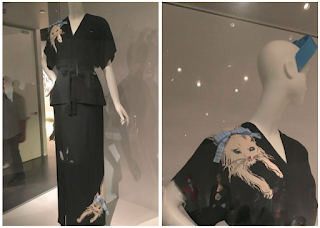 |
| Offering Bearer, Egypt, c.1981 - 1975 BC. |
I blogged about the first part of the tour here, and this post explores the Schreier collection of 20th century fashion, with a focus on pieces which reference historic costume or have interesting narratives. Also, I feature items which just appeal to me; after all, it's my blog.
Now, the first image in this blog is a 4,000 year-old representation of ancient Egyptian dress. The second image, of an evening dress by Madeleine and Madeleine, clearly references the Egyptian revival motifs which became all the rage after the discovery of King Tutankahmun's tomb in 1922, not to mention silent film star Theda Bara's portrayal of Cleopatra in 1917.
While the 1920's dress features a girdle of an Egyptian-inspired bird delineated in fake jewels, the silhouette of the dress is thoroughly 1920's. While the ancient dress clings to the body, showing every curve, the flapper-era dress falls straight and away from the body, with no accent on the bosom; only the bird motif girdle creates a feminine emphasis at the hips.
Mariano Fortuny Y Madrazo, more widely known just as Fortuny, was another designer who translated aspects of ancient dress into contemporary fashion. His famous Delphos dress, an elegant straight gown whose infinite tiny pleats skimmed the body, references ancient Greek female attire. Fortuny still exists and made some of the outfits for Downton Abbey.
 |
| Fortuny gown and tunic, 1920's. |
 |
| Downton Abbey Delphos-style dress by Fortuny. |
So clearly, fashion designers, just like artists in many media, looked to the past for inspiration, one theme of this exhibit. Another theme is the manner in which designers respond to economic or political conditions. Some of the garments were designed by Gilbert Adrian, a busy Hollywood designer best known by the monomym Adrian. The ensemble below was designed during World War II, when Regulation Order L-85 (scroll down to the "Dressing for War" section) put limitations on the use of silk, among other fabrics. So, designers used alternative materials such as rayon, seen in this burgundy sheath style dress. Fringe, however, was unrestricted, so could be used with abandon.
 |
| Rayon dress with fringe, Gilbert Adrian, c. 1943. |
Adrian, who designed Judy Garland's blue-and-white gingham outfit in the Wizard of Oz, also produced one of my favorites in the show, below.
 |
| Rayon dress with printed cats, Gilbert Adrian, 1944. |
The garments exhibited also featured examples of amazing handwork - beading, embroidery, passmenterie and so forth, and it's great to see this craftsmanship celebrated, on accessories as well as clothes. It's also time to be no longer ashamed of the decorative impulse. Imagine the dress below on a Bright Young Thing out on the town and dancing, fringe flying and light sparkling on the beads.
 |
| Evening dress, French or American, c. 1925-28. |
 | |||
| Helmet hat, 1920's. |
As noted in the exhibit, hats and other accessories made couture a bit more inclusive - these items of clothing were independent of body shape and offered a way to experience a bit of high fashion with less of an investment. Hats were also a way to introduce a little bit of levity into the fashion equation.
 |
| Hat, Philip Treacy, 2003. |
You may remember admiring Treacy's hats at the wedding of Prince William and Katherine Middleton in 2011. Within the compass of headgear, Treacy exhibits a lot of creativity.
Well, this post covers just a fraction of the items on view, and, judging from the crowds, this is a popular exhibit. The Met is lucky Ms. Schreier is donating much of her collections to its Costume Institute. There is a catalog available.
 |
| Evening coat, detail, French, 1923-28. This view captures the glimmer of silver lamé. |




















